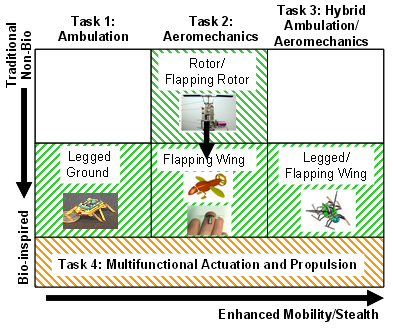![]() Research
Research
Fundamental Research Philosophy
 Our center research philosophy is to develop experimental test-beds only when necessary to validate our understanding and use of biological principles and to demonstrate microsystem functionality, performance and mobility. Because our key center theme is to leverage biology to achieve enhanced distributed mobility at small scales, we will develop experimental platform testbeds across three of the four technical task areas.
Our center research philosophy is to develop experimental test-beds only when necessary to validate our understanding and use of biological principles and to demonstrate microsystem functionality, performance and mobility. Because our key center theme is to leverage biology to achieve enhanced distributed mobility at small scales, we will develop experimental platform testbeds across three of the four technical task areas.
As depicted in the above figure, our goal in Tasks 1 thru 3 will be to focus directly on bio-inspired platforms at the macroscale (50 to 100 cm) to verify modeling tools, performance, functionality and mobility with an eye towards developing a better fundamental understanding of the physics that will enable the design of microsystems at the mesoscale (1 to 10 cm).
Task 4 serves as an enabling technology for legged, flapping and hybrid microsystems. In this task, methods for manufacturing and engineering high strength to weight ratio structural elements will be researched coupled with efficient ways to deliver and distribute actuation power to legged and flapping appendages. In addition, Task 4 provides the foundation for the development of lightweight rotor/wing and ambulation structures that will be used to demonstrate multi-body kinematics, dynamics and performance associated with ambulation and flight.
In each of the four main tasks proposed in our center, we will try to find answers to the following important microsystem mechanic questions:
- What are the fundamental biological principles that govern walking, running, flying, maneuverability, and hopping performance at all scales?
- What key non-dimensional scaling (Reynolds, Richardson and Rossby numbers), parameters characterize observed biological phenomena?
- What are the key kinematic degrees of freedom associated with ambulation and flight mobility?
- How is energy stored and released efficiently to achieve mobility in nature?
- What manufacturing processes will lead to efficient lightweight high strength to weight structural elements for ambulation and flight?
Answers to these and other fundamental research questions will be obtained using a systematic research approach that involves the development of rigorous modeling/analysis tools coupled with experimental testing. Validation and verification will be carried out at every step and scale size of our program to ensure that our tools are useful and accurate in modeling observed phenomena.
![]()
Research Home | Research Tasks | Research Labs
